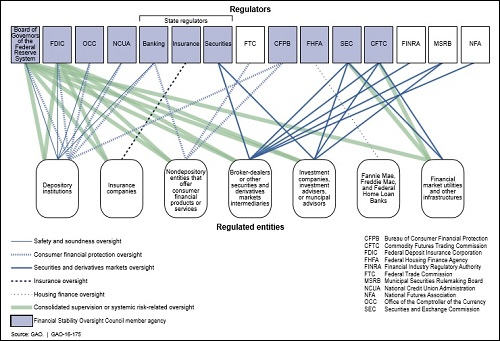By Pam Martens and Russ Martens: March 30, 2016
Who could blame the researchers at the Government Accountability Office (GAO) for thinking that responding to Congressional requests for studies on how to repair the nation’s ineffective maze of financial regulation is an exercise in futility. GAO has been spending boatloads of taxpayer money for the past two decades to define the problems for Congress as our legislative branch has not only failed to take meaningful corrective measures but actually made the system exponentially worse through the repeal of the Glass-Steagall Act in 1999.
During the 20 years that GAO has been warning about an ineffective financial regulatory system, taxpayers have been looted through a nonstop series of massive Wall Street frauds: the Nasdaq price fixing scandal; the rigged Wall Street research scandal leading to the $4 trillion dot.com bust; the four-decade Ponzi scheme of Bernie Madoff that was defined in meticulous written detail to a deaf and blind SEC by Harry Markopolos years before Madoff’s confession; and the epic Wall Street collapse of 2007-2009 that took down the entire U.S. economy in the biggest bust since the Great Depression. (Those are just the major milestones. For a look at what just one bank, JPMorgan Chase, has been up to in just the past four years, check out this chronology; or this Citigroup rap sheet. )
And what did Congress do after the 2008 crash to fix the problem? It handed even greater oversight powers to the regulator that didn’t see the crash coming and that had defied Congress by secretly funneling over $13 trillion in below-market-rate loans to teetering Wall Street banks – including at least one that was insolvent at the time (Citigroup). We’re talking about the Federal Reserve – the agency that still has no Vice Chairman for Supervision of Wall Street banks as required under the homage-to-Wall-Street law known as Dodd-Frank, passed over five years ago.
Why the Federal Reserve, the nation’s central bank, which has a monetary policy mandate, should also be in charge of supervising the behemoth Wall Street banks’ (especially when it abysmally failed in that job leading up to the crash) has yet to be explained to the American people.
GAO is a nonpartisan agency that investigates matters requested by members of Congress to determine if taxpayers’ money is being spent in the most effective manner. All one has to do is take a quick look at the graphic below that came with the latest GAO study on the “complex and fragmented” structure of the U.S. financial regulatory system to understand that this mess exists because that’s the way Wall Street wants it to exist. A fragmented system of silos allows Wall Street to continue to loot the public with impunity by gaming the myriad loopholes in the system. And allowing an industry with this serial history of crime to run its own private justice system is like giving the Mafia their own courthouse.
The GAO’s latest missive came this past Monday with the timid title “Financial Regulation: Complex and Fragmented Structure Could Be Streamlined to Improve Effectiveness.” The report makes a number of key recommendations for Congress to consider, including “consolidating the number of federal agencies involved in overseeing the safety and soundness of depository institutions”; “combining the entities involved in overseeing the securities and derivatives markets [Securities and Exchange Commission and Commodity Futures Trading Commission]”; “transferring the remaining prudential regulators’ consumer protection authorities over large depository institutions to CFPB [Consumer Financial Protection Bureau]”; and beefing up the ability of the Financial Stability Oversight Council to effectively respond to systemic risks in the system once they are identified.
This particular GAO report feels timid and reserved, given that Wall Street singlehandedly sacked the nation’s economy just seven years ago and left us in a subpar growth twilight zone for what looks like an indefinite period. As the GAO itself wrote in 2013, the long-term impact of the 2008 financial collapse could result in cumulative output losses exceeding $13 trillion. GAO noted:
“Some studies describe reasons why financial crises could be associated with permanent output losses. For example, sharp declines in investment during and following the crisis could result in lower capital accumulation in the long-term. In addition, persistent high unemployment could substantially erode the skills of many U.S. workers and reduce the productive capacity of the U.S.”
This is the worst possible time for the GAO to go timid on the American people. Unfortunately, this report feels like the Hillary Clinton version of financial reform: tinker around the edges and stay the disastrous course we’re currently on.
As Wall Street On Parade has repeatedly warned, nothing will rebalance the massive wealth and income inequality or stop further epic crashes on Wall Street than the restoration of the Glass-Steagall Act. (See related article below.)
Related Articles:
Dodd-Frank Versus Glass-Steagall: How Do They Compare?
A 1994 Report from GAO Warned Congress That Wall Street Could Explode
GAO Report: Cost of the Financial Crisis — Your Retirement
GAO Report: SEC Is Bungling Collection and Accounting of Billions in Fines



